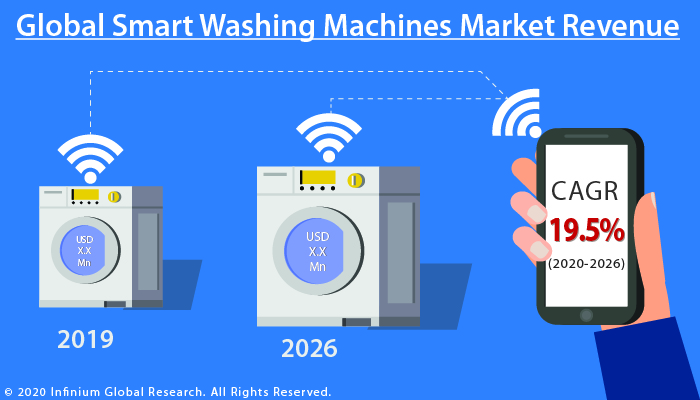Smart Washing Machines Market (Product Type - Top Load, and Front Load; Connectivity - Wi-Fi, NFC (Near-field Communication), Bluetooth, and Others; End User - Residential, and Commercial): Global Industry Analysis, Trends, Size, Share and Forecasts to 2026
A recent report published by
Infinium Global Research on smart washing machines market provides in-depth
analysis of segments and sub-segments in the global as well as regional smart
washing machines market. The study also highlights the impact of drivers,
restraints, and macro indicators on the global and regional smart washing
machines market over the short term as well as long term. The report is a
comprehensive presentation of trends, forecasts, and dollar values of the global
smart washing machines market. According to the report, the global smart
washing machines market is projected to grow at a CAGR of 19.5% over the
forecast period of 2020-2026.
Market Insight
The appliance industry worldwide
has been stunned out of its slumber due to the hard competition. Nowadays all
brands are competing with their counterparts to pull the greatest number of
customers towards them. The global smart washing machine market is predicted to
rake in an ample amount of demand from the residential sector as consumers
reveal a major preference toward smart and connected products. Vendors in the
market are taking to products that can be managed and controlled with a few
touches on the consumer’s smartphone. As smart washing machines use smart grid
technology and promote efficient energy utilization, many government bodies are
encouraging their use for saving energy and resources. These machines can be
connected with smart grids or with users at home via Bluetooth, near field
communication (NFC), or Wi-Fi. NFC technology is also used in a smart diagnosis
feature that can alert users about technical issues.
Wireless connectivity is now being
extended to a wide range of household appliances moving beyond smartphones and
tablets, enabling them to collect and exchange data. The growing use of
wireless connecting devices and the Internet of Things (IoT) is driving the
growth of the smart washing machines market. Furthermore, the need for
energy-efficient washing machines provides a growing demand for the market.
Growing demand for energy-efficient home appliances is influencing the adoption
of smart washing machines. It is designed and developed for capably using
energy by connecting them with smart grids. A smart washing machine is mechanically scheduling wash cycles using
time-based electricity programs to ensure the washing machine is operating
during off-peak hours when energy prices are cheaper. Additionally, the
increased government support for promoting smart homes and smart appliances is
another major growth driver for the global smart washing machine market. The
majority of governments are now encouraging manufacturers to develop and
consumers to adopt domestic appliances that use smart grids. However, the high
cost of smart washing machines is a major restraining factor that will likely
affect their adoption, and in turn, the growth of the market. Owing to this
high-cost factor, it becomes difficult for manufacturers to convince consumers
to upgrade their regular washing machines with the smart connected variety.
Moreover, rapid technological advancement is provided significant growth
opportunities for the market. The
current concerns over the spread of coronavirus are creating a huge impact on
the smart washing machines market. COVID-19 pandemic affected the global smart
washing machines market by hindering production and demand, by disrupting the
supply chain and appliance market disruption, and by its impact on firms and
the financial markets. The worldwide appliance industry is heavily dependent on
Chinese manufacturers. Lockdown in China has caused severe demand-supply gaps
in the industry. The gap in the demand-supply chain will hinder the functioning
of the flourishing smart appliances industry.
Among the geographies, the Asia
Pacific dominated the global smart washing machine market. Countries such as
China, India, and Japan hold a major share of the smart washing machine market
in the Asia Pacific and offers significant growth potential in this region. The
Asia-Pacific market is largely driven by technological advancements and
internet penetration rate in developing economies, such as China and India.
According to the China Internet Network Information Center (CNNIC), internet
penetration in China is 59.3%. Europe holds the second-largest market share for
the smart washing machine market. Technological advancements that have
increased comfort level and convenience for customers are collectively fueling
the growth of the market in the European region. The increased spending power
of the people and growing working women populace in countries such as the U.S.
and Canada boosts the growth of the smart washing machine market in the North
America region.

Segment Covered
The report on the global smart washing
machines market covers segments such as product type, connectivity, and end
user. On the basis of product type, the sub-markets include top load and front
load. On the basis of connectivity, the sub-markets include Wi-Fi, NFC (near-field
communication), bluetooth, and others. On the basis of end user, the
sub-markets include residential, and commercial.
Companies Profiled:
The report provides profiles of
the companies in the market such as Siemens AG, LG Electronics Inc., AB
Electrolux, Whirlpool Corporation, Haier Group, Robert Bosch GmbH, Techtronic
Industries, GE Appliances, Samsung Electronics, and Candy Group.
Report Highlights:
The report provides deep insights
into the demand forecasts, market trends, and micro and macro indicators. In
addition, this report provides insights into the factors that are driving and
restraining the growth in this market. Moreover, The IGR-Growth Matrix analysis
given in the report brings an insight into the investment areas that existing
or new market players can consider. The report provides insights into the
market using analytical tools such as Porter's five forces analysis and DRO analysis
of smart washing machines market. Moreover, the study highlights current market
trends and provides forecast from 2020-2026. We also have highlighted future
trends in the market that will affect the demand during the forecast period.
Moreover, the competitive analysis given in each regional market brings an
insight into the market share of the leading players.
Request Quote